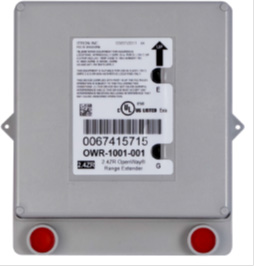How to Tell If I Have a Smart Meter
- DTE’s Smart Meter: The Itron Centron OpenWay Meter
- Consumers Energy’s Smart Meter
- Digital Meter
- DTE’s Digital Meter That Can Be Converted to a Smart Meter
- Analog Meter (the meter most people have before a smart meter is installed)
- Analog Meters That Have Hidden Transmitters
- Meters for Other Michigan Utilities
- What does the face of the advanced (smart) meter tell me?
- Gas Smart Meter
DTE’s Smart Meter: The Itron Centron OpenWay Meter
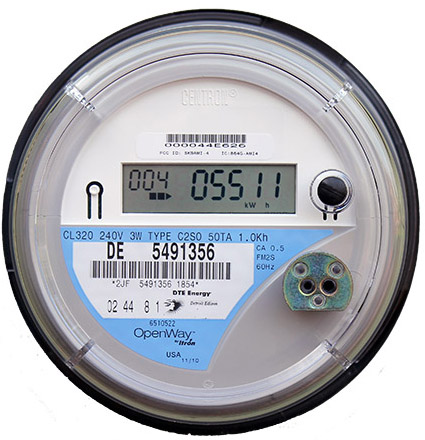
This is a picture of the new Itron Centron OpenWay smart meter that DTE is installing on homes and businesses. DTE calls it an advanced meter to avoid the negative associations people have with smart meters. The blue on the face of the meter is what gives it away. As you can see, it also has a digital LCD display. It is the smart meter’s digital nature (not only the radiofrequency ti emits) that causes many of the health problems. See our page on dirty electricity and on the DTE opt-out program.
The numbers you will see on the meter will likely be CL200 240V 3W TYPE C2SOD 30TA 1.0KH. This means Class 200, 240 volts, 3-wire, Type C2SOD (the “D” stands for “remote disconnect,” meaning they can shut your service off without coming out to your home), 30 Test Amps, 1.0 Kilo-watt hour constant. For more information on what these numbers mean, see the eHow article. A meter might also say C2SO, meaning it has no remote disconnect capability. Most, if not all, home meters have remote disconnect. Business meter seem to vary, and there are a huge variety of business meters out there, despite DTE's contention that it is replacing all meters with “one meter type.”
(Click here for more information on their digital nature and health.)
Consumers Energy Smart Meter
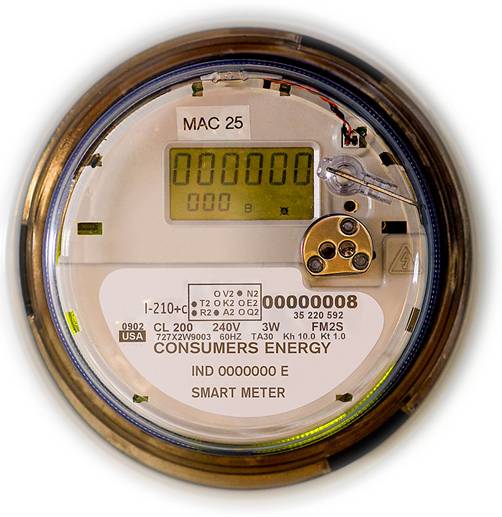

Consumers Energy is installing two different smart meters, as you can see from the above pictures. Here is a link to a PowerPoint presentation from PG&E, the California utility, which has also installed these meters.
Digital Meter
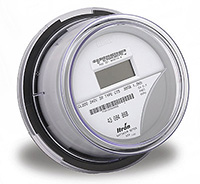 Beginning in 2006, DTE ceased to install analog meters. This picture shows a commonly installed digital meter found in Michigan, the Itron Centron (brochure, technical guide). This meter likely generates less dirty electricity than DTE’s Itron OpenWay smart meter because it does not collect the same fine-grained usage data as a smart meter. However, because it is a digital meter, it still generates dirty electricity (voltage transients and harmonics). It is likely that the older the digital meter, the less dirty electricity it generates because it is doing less data-gathering. You can find the date code at the bottom of the meter. If you think you have one of these meters, you may want to keep it instead of getting a new smart meter! To get some idea of the amount of dirty electricity it generates, buy a Stetzer meter or a Trifield meter (or both) and measure the amount of line noise and the strength of the magnetic field in your home. The Stetzer meter will measure the line noise (dirty electricity). The Trifield meter will measure the magnetic field and how much it fluctuates. A needle that fluctuates a lot means there is a very unstable, erratically pulsating magnetic field. Pulsating electromagnetic fields are very harmful to human health. Numbers and letters you see on this meter will include CL200 240V 3W TYPE C1S 30TA 1.0KH, CA 0.5, FM2S, 60Hz. To learn more about what these numbers mean, see this eHow article.
Beginning in 2006, DTE ceased to install analog meters. This picture shows a commonly installed digital meter found in Michigan, the Itron Centron (brochure, technical guide). This meter likely generates less dirty electricity than DTE’s Itron OpenWay smart meter because it does not collect the same fine-grained usage data as a smart meter. However, because it is a digital meter, it still generates dirty electricity (voltage transients and harmonics). It is likely that the older the digital meter, the less dirty electricity it generates because it is doing less data-gathering. You can find the date code at the bottom of the meter. If you think you have one of these meters, you may want to keep it instead of getting a new smart meter! To get some idea of the amount of dirty electricity it generates, buy a Stetzer meter or a Trifield meter (or both) and measure the amount of line noise and the strength of the magnetic field in your home. The Stetzer meter will measure the line noise (dirty electricity). The Trifield meter will measure the magnetic field and how much it fluctuates. A needle that fluctuates a lot means there is a very unstable, erratically pulsating magnetic field. Pulsating electromagnetic fields are very harmful to human health. Numbers and letters you see on this meter will include CL200 240V 3W TYPE C1S 30TA 1.0KH, CA 0.5, FM2S, 60Hz. To learn more about what these numbers mean, see this eHow article.
DTE’s Digital Meter That Can Be Converted to a Smart Meter
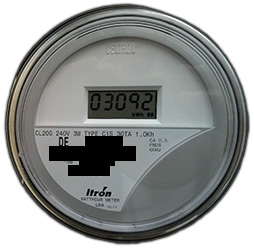
The Itron CL200 C1S meter is not a meter you want! This meter has been installed on homes for some time. Supposedly DTE is “upgrading” these to the Itron OpenWay meter, but we know of instances where DTE has installed this meter as the opt-out meter, despite DTE's contention that it is converting all meters to “one meter type.”
To know whether you have this meter, look at the picture. On the meter you will see: CL200 240V 3W TYPE C1S 30TA 1.0Kh. This meter is a digital meter that is capable of being converted to a smart meter by the addition of a "personality" module. We have measured the voltage transients and harmonics (dirty electricity / line noise) and magnetic fields generated by this meter. This meter is almost as bad as the smart meter. A woman who lives in a home with this meter has had her health severely affected by it, nearly as severely as by the smart meter that was previously installed on her home. Two other electrosensitive people who have gone to this home have also experienced severe problems. For a list of the health effects experienced by people when exposed to this meter, click here. Also read Rebecca’s story, Cynthia’s story, and Linda’s story for more detailed information. The woman who (tries) to live in this home spends most of her time travelling in order to avoid the degrading effects of this meter on her body. The digital meter (see previous entry) that looks similar to the CL200 C1S does not seem to generate the dirty electricity that the CL200 C1S does, probably because it is not measuring electricity usage in detail.
Analog Meter (the meter most people have before a smart meter is installed)
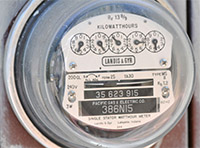 The analog meter does not involve any electronics. Thus it does not create dirty electricity / noise on the line. However, note that some meters that look like analog meters actually have hidden transmitters. More on that in the next section. The “clock” dials on the meter indicate how much electricity you have consumed. Below the dials is a large rotating disk that spins faster as you use more energy on your property. The spinning of the disk (a mechanical movement) is how the meter measures your electrical usage.
The analog meter does not involve any electronics. Thus it does not create dirty electricity / noise on the line. However, note that some meters that look like analog meters actually have hidden transmitters. More on that in the next section. The “clock” dials on the meter indicate how much electricity you have consumed. Below the dials is a large rotating disk that spins faster as you use more energy on your property. The spinning of the disk (a mechanical movement) is how the meter measures your electrical usage. 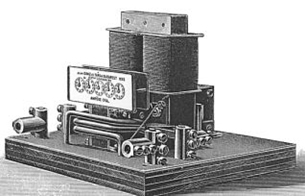 This is a picture of the analog meter (electromechanical meter) that, in similar form, has been used since 1889! DTE insiders tell us that the utility still has analog meters that were installed in the 1950s—that’s 60-plus years of accurate energy measurement. Note that there are now meters being made that have the dials on them (they look like analog meters) but actually record digitally. To our knowledge, none of these meters are being installed in Michigan. If you do not have an analog meter and want one on your home, you can consider replacing your meter.
This is a picture of the analog meter (electromechanical meter) that, in similar form, has been used since 1889! DTE insiders tell us that the utility still has analog meters that were installed in the 1950s—that’s 60-plus years of accurate energy measurement. Note that there are now meters being made that have the dials on them (they look like analog meters) but actually record digitally. To our knowledge, none of these meters are being installed in Michigan. If you do not have an analog meter and want one on your home, you can consider replacing your meter.
Analog Meters That Have Hidden Transmitters
Some meters look like analog meters (and are in one sense analogs), but they have a hidden transmitter in them. These are the meters that have been installed by most rural electric cooperatives in Michigan, as well as some of the privately owned utilities. It is possible that some homes in DTE and Consumers territory also have these meters. These meters are discussed here and below, under Meters for Other Michigan Utilities. They include AMR, PLC, BPL, and TWACs.
If you have had trouble sleeping for a decade or more, then one of these meters could be the culprit. (If you have wireless in your home, then that is a likely culprit as well.) These meters transmit wirelessly or by PLC (power-line communication), or by a combination of the two (TWACs). All of these methods create dirty electricity because they involve computer circuitry being installed in the meter. For an excellent discussion of these “stealth” meters, please go to http://www.eiwellspring.org/smartmeter/StealthMeters.htm, and also read this article in its entirety, as well as here, here, and here.. You can also visit Sal La Duca’s page on Turtle meters, where he notes that “a module on the meter would impress digital data right onto the power wiring. . . . The primary frequency was in the order of five to 9.5 Hz (5 - 9.5) and was either coded as a Morse-type intermittent signal, or continuous and modulated with the desired data. . . . [A]pplication of this form of AMR is waning, because data transport is slow. . . . [T]he frequency used for data cartage is within the range of brain waves, and since it is directly impressed on the power wiring, its conveyance is not only toward the electrical substation data collection point, but also toward the indoor living space.”
Health Effects. An interesting note regarding the health effects of these meters has been contributed by one member of the Smart Meter Education Network: “I grew up in a home with an analog meter. I moved away in 1980, but each year I would go back to my parents’ home to visit them. At some point, I began to sleep better at their home than in my own. Then, suddenly, in 2002 I slept very poorly when I went to visit them. I attributed it to the break-up of a relationship. But every year thereafter, I would toss and turn all night. In 2012, I learned that a Turtle meter, an analog look-alike that transmits electricity usage over the power line [PLC] had been installed on their home in January 2002, the year I began sleeping poorly when I visited them.” Within a few years of the meter’s installation, her mother developed atrial fibrillation and her father developed high blood pressure. Both had always been in excellent health, were vegetarian, and kept themselves in good shape by hiking and doing daily farm and ranch work.
LaDuca notes: “A no-impact AMR metering scheme would be the one long employed by the utility with large usage customers, with a voice-grade telephone line to each meter, but this goes against the grain of least-cost efforts.”
For an excellent, comprehensive discussion of PLC and TWACS, and also the health issues created by this method of meter-reading, read this article in its entirety, as well as here, here, and here.
Other Michigan Utilities
If you are a customer of a utility mentioned below, please contact us. Please do your best to gather information about your utility and smart meters prior to contacting us. You can call your utility, and you can do a web search. Please send us the information so that we can provide it to others. Some of these utilities may have changed their programs since this information was posted.
In General
AMI (smart meters), AMR, PLC, and TWACs are the different meter-reading methods being employed by the smaller utilities. Please read the information under Analog Meters That Have Hidden Transmitters, above, and under Great Lakes, below, to understand the health risks and problems with these meters. These meters cause serious health problems, often quite hidden because no association is made between the problem and the installation of the meters, in particular because the health problems build up slowly.
According to Michigan Public Service Commission Report U-17000: “Alpena Power plans to change to digital meters but does not intend to install smart meters. . . . I&M has Automated Meter Reading (AMR) at nearly all of its Michigan accounts and does not intend to replace those with smart meters. All of Northern States Power’s Michigan customers have AMR, which send daily reads. Northern States Power does not intend to allow opt-out, but believes customers should pay for that option if an opt-out plan is required. Upper Peninsula Power uses electromechanical [analog] meters and is planning to continue this method. Wisconsin Electric Power Company (WEPCO) has installed AMR throughout its Michigan territory. WEPCO does not anticipate offering opt-out of AMR. Wisconsin Public Service Corporation has meters with both one and two-way communication. Its systems have been in place for over 10 years.”
Most of the electric cooperatives have installed meters that transmit over the power line (PLC or TWACs). Some of these meters have two-way communication. At least some of these meters are smart meters. None of these cooperatives intend to allow an opt-out. The cooperatives are: Alger Delta Cooperative, Cherryland Electric Cooperative, Cloverland Electric Cooperative, Great Lakes Energy Cooperative, HomeWorks Tri-County Cooperative, Midwest Energy Cooperative, Ontonagon County Rural Electrification Association, Presque Isle Electric & Gas Cooperative and Thumb Electric Cooperative.
As of 2012, Presque Isle had a 10-meter AMI pilot.
Great Lakes Energy Smart Meters
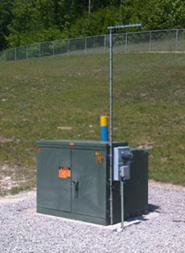 Great Lakes Energy has implemented a hybrid metering system, known as Aclara TWACs (Two-Way Automatic Communication System). The hybrid system uses a cellular network as well as PLC (power-line carrier, also know as BPL). PLC transmits data over the power line, thus contaminating both home wiring and the power line. It is used mainly in rural areas. “The cellular network’s speed can provide readings from six meters in the same time as one reading from a dial-up connection.” For an excellent, comprehensive discussion of PLC and TWACS, and also the health issues created by it, read this article in its entirety, as well as here, here, and here. Read industry information here, here, and here.
Great Lakes Energy has implemented a hybrid metering system, known as Aclara TWACs (Two-Way Automatic Communication System). The hybrid system uses a cellular network as well as PLC (power-line carrier, also know as BPL). PLC transmits data over the power line, thus contaminating both home wiring and the power line. It is used mainly in rural areas. “The cellular network’s speed can provide readings from six meters in the same time as one reading from a dial-up connection.” For an excellent, comprehensive discussion of PLC and TWACS, and also the health issues created by it, read this article in its entirety, as well as here, here, and here. Read industry information here, here, and here.
Prior to installation of Aclara TWACS, Great Lakes used a system that transmitted data over the phone line. This system caused dirty electricity, the same kind DTE’s opt-out meter causes. The TWACS system is marketed by Aclara, which produces modules that are installed inside meters from other vendors. Smart meters with a TWACS transmitter may have a special label with the Aclara logo on it. It is usually placed on the front, but could be elsewhere. The Aclara logo is a red square with rounded corners and two crossed white lines. TWACS-compatible equipment is also marketed by Itron/Schlumberger and Landis+Gyr under the DCSI name. These may be identified by a label with the equipment model, such as “DCSI-EMT-3F” or similar. Some TWACS meters, like those used by Great Lakes, also have built-in wireless transmitters. These are mostly used to get meter readings from gas and water meters on the house. The electrical meter then passes that information on, using the TWACS system. The Aclara Badger ORION product is such a system.
What does the face of the advanced (smart) meter tell me?
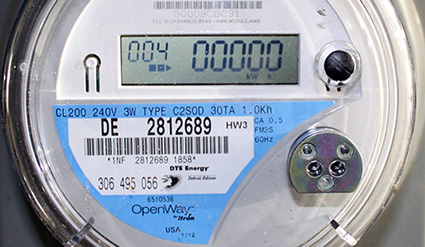
The numbers you will see on a residential Itron OpenWay smart meter will likely be CL200 240V 3W TYPE C2SOD 30TA 1.0KH. This means Class 200, 240 volts, 3-wire (not watts), Type C2SOD (the “D” stands for “remote disconnect,” meaning they can shut your service off without coming out to your home), 30 Test Amps, 1.0 Kilo-watt hour constant. For more information on what these numbers mean, see the eHow article. A meter might also say C2SO, meaning it has no remote disconnect capability. Most, if not all, home meters have remote disconnect. Business meter seem to vary, and there are a huge variety of business meters out there, despite DTE's contention that it is replacing all meters with “one meter type.”
“3W” does not mean that the meter consumes 3 watts of power. It actually consumes 5 watts or more (yes, smart meters require electricity to run, unlike the analog meter). "3W" means that the meter is meant to be installed on a utility panel that uses 3 wires for the electricity.
Click here to learn more about what features currently exist with these new smart meters.
Gas Smart Meter
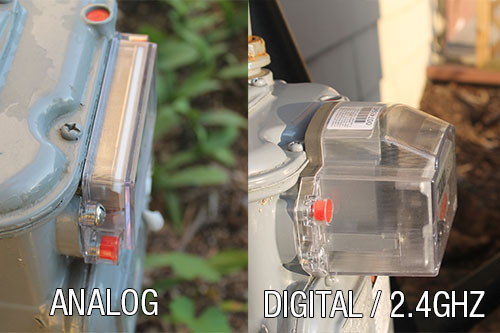
DTE allows you to opt out of the gas smart meter. Learn more
The easiest way to tell if your gas meter has been converted is to look at the gas meter itself. Here is a side profile comparison. As you can see, the digital meter typically sticks out much farther than the analog one. It is about three inches thick. The analog is about an inch. That is your most certain way to tell if you have a smart gas meter. Note that the smart gas meter may still have an analog read-out, meaning the "clock dials."
If your gas meter is inside your home, check for a wire running from the meter to the outside. If there is a wire, you have a gas smart meter. Beware! DTE employees will tell you they are there just to read the meter, then switch your meter out. In one instance, a customer accompanied the employee downstairs to the basement. He did not change out her meter. They got to the top of the stairs. He told her he had forgotten something downstairs. He was back within a minute. He had changed out her meter in that one minute!
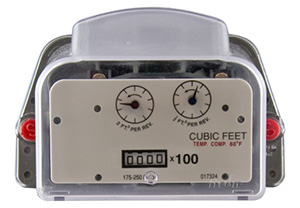 SEMCO is telling customers that the above meter is not a smart meter. It is. From Itron’s website: “The 100G module is Itron’s most advanced gas ERT® module. Capable of collecting time-synchronized daily or hourly metering data and of two-way communications . . . . It automatically stores 40 days of hourly data–a “black box” of hourly usage. . . . Work equally well whether indoors or outdoors, and are powered by replaceable “A” cell lithium batteries that provide a battery life of 20 years.”
SEMCO is telling customers that the above meter is not a smart meter. It is. From Itron’s website: “The 100G module is Itron’s most advanced gas ERT® module. Capable of collecting time-synchronized daily or hourly metering data and of two-way communications . . . . It automatically stores 40 days of hourly data–a “black box” of hourly usage. . . . Work equally well whether indoors or outdoors, and are powered by replaceable “A” cell lithium batteries that provide a battery life of 20 years.”
Gas meters may also have range extenders installed next to them. These range extenders allow the gas meter to transmit much farther than they otherwise would. The smart gas meter is designed to interact with an individual customer’s smart electric meter. If there are obstructions, such as foliage or a house wall, the smart gas meter may not be able to communicate with the smart electric meter.
Gas smart meters have caused severe health problems for some people, including loss of ability to speak, just as if one had had a stroke.
There will be a sticker on the top of the gas module that looks something like this.
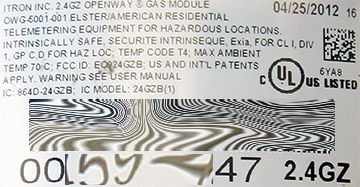
As you can see from the top line, the sticker says: ITRON INC. 2.4GZ OPENWAY GAS MODULE, FCC ID: EO924GZB, IC:864D-24GZB; IC MODEL: 24GZB(1). These numbers may very a bit depending on the location of the country you are in.
The gas smart meters transmit a wireless signal to your smart electric meter. Gas meters are typically on the opposite side of the house as the electric meter, so it’s that much more wireless going through your home. To learn how to keep a gas meter off your home, click here. Note that DTE does not install gas smart meters and electric smart meters at the same time.
Newsletter, Facebook—Stay Up to Date
Stay up to date by subscribing to our newsletter (it comes out every 1 to 4 weeks). We constantly update our website, so check back often. You can find updates and time-sensitive actions to take under our “Alerts and Breaking News” box. We also use Facebook to send out quick news updates. (While we understand the privacy concerns with Facebook, at this point in time it is a useful tool for us, and is a great way to spread the word about smart meters. If you only wish to use Facebook for access to our updates, you can get an account without revealing personal information—it’s all in what you choose to share, and you can give them any name or birthdate you like.)
Our newsletter comes out every 1 to 4 weeks. It will keep you informed and tell you what actions you can take to fight smart meters. Note that most email programs will filter out our newsletter unless you adjust your email settings. Even though you may receive individual emails from us, when we send the newsletter out to a large group, the emails may be placed in a folder other than your inbox. This happened to us! We weren’t even getting our own newsletter.. Please make sure you look for emails from smartmetereducationnetwork@ gmail. com in your Promotions, Spam, Junk, or other folders. Please contact your email provider to learn how to adjust your settings, or search on the internet.
Terms to Know
Advanced meter: smart meter (term used by DTE to hide the fact it is a smart meter).
AMI meter and AMI program: another name for the smart meter and the smart meter program. AMI stands for advanced metering infrastructure.
Blood-brain barrier: EMFs can cause the blood-brain barrier to be breached, allowing toxins to enter the brain. Toxin entry is thought to be partially responsible for Alzheimer’s, dementia, and Parkinson’s.
Dirty electricity: spiky, pulsed electromagnetic field generated by smart meters that rides through building wiring and permeates the building’s rooms. Responsible for many of the health problems seen with smart and digital meters.
Electromagnetic fields (EMFs): consist of an electrical field and a magnetic field. Fields are created by the flow of electrical current through the wire, sunlight, etc.
Electromagnetic frequency: examples are 60 Hz electrical current of your home, RF of a cell phone. Often used interchangeably with electromagnetic field.
Electromagnetic hypersensitivity (EHS): sensitivity to electromagnetic fields. Symptoms are complex and involve all bodily systems
Hydrogen bonds: Electrostatic bonds that help hold the DNA double helix together. Breakage of hydrogen bonds may cause changes in DNA that can lead to cancer. RF and other EMFs may disrupt the Hydrogen bonds.
Meter upgrade: the installation of an advanced (smart) meter on your home by DTE.
Microwave radiation: the type of radiation emitted by smart meters. Known to cause biological harm.
Non-transmitting meter: another name for the DTE and Consumers opt-out meters.
Opt-out meter: this is a smart meter. The only thing that is different is the radio-transmitter is turned off. It still generates dirty electricity, it still retains the two antennas, and it is only incrementally less harmful to your health. It can still record detailed information about your electrical usage.
Radio-disabled meter: another name for the DTE opt-out meter.
Radio-off meter: another name for the DTE opt-out meter.
Radiofrequency (RF): high-frequency electromagnetic waves in the range of 10 MHz to 300 Ghz. All wireless devices, including smart meters, cell phones, and Wi-Fi emit RF.
Switched mode power supply: contained in all smart meters, it creates dirty electricity.
van der Waals bonds: an extremely weak electromagnetic force that helps hold the DNA double helix together. Breakage of the van der Waals bond may cause changes in DNA that can lead to cancer. RF and other EMFs can disrupt the van der Waals bonds.

